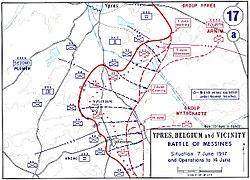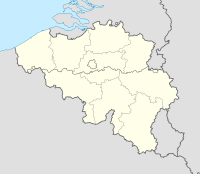| Capture of Wytschaete | |||||||
|---|---|---|---|---|---|---|---|
| Part of the Battle of Messines (1917) of the First World War | |||||||
 Map of the battle, depicting the front on 7 June and operations until 14 June | |||||||
| |||||||
| Belligerents | |||||||
|
|
| ||||||
| Commanders and leaders | |||||||
|
Sir Douglas Haig Sir Herbert Plumer |
Rupprecht, Crown Prince of Bavaria Sixt von Armin | ||||||
| Units involved | |||||||
| IX Corps | Gruppe Wijtschate (XIX (2nd Royal Saxon) Corps) | ||||||
| Strength | |||||||
|
36th (Ulster) Division 16th (Irish) Division | 2nd Division | ||||||
| Casualties and losses | |||||||
|
36th (Ulster) Division: c. 700 16th (Irish) Division: 1,183 (6/7–9 June) | 3,563 | ||||||
Wytschaete (historically used in English for Wijtschate) on Messines Ridge, in the Belgian province of West Flanders | |||||||
The Capture of Wytschaete was a tactical incident in the Battle of Messines (7–14 June 1917) on the Western Front during the First World War. On 7 June, the ridge was attacked by the British Second Army; the 36th (Ulster) Division and the 16th (Irish) Division of IX Corps captured the fortified village of Wytschaete on the plateau of Messines Ridge, which had been held by the German 4th Army since the First Battle of Ypres (19 October – 22 November 1914).
In April 1917, the senior German commanders in Flanders were willing to contemplate a retirement from the Messines salient (Wytschaetebogen) but the local Gruppe (corps) and divisional commanders objected. The convex slope of the eastern side of the ridge would obstruct artillery observation and the proximity of the Ypres–Comines Canal and the river Lys would hamper the assembly of reserves. The Germans had spent two years fortifying the defences and the local commanders had been assured that British mining attempts had been defeated.
The British attack at Messines was set for 7 June and the plan included the detonation of deep mines that had been laid under the German front position since 1915. IX Corps was due to attack the apex of the German salient and advance 3,000 yd (1.7 mi; 2.7 km), to capture the fortified village of Wytschaete and the far side of the plateau. The divisional boundary of the 36th (Ulster) Division and the 16th (Irish) Division ran through the village and battalions of both divisions overran the remaining defenders and captured the village by 8:00 a.m.
The German 2nd Division occupied the Wytschaete sector and its infantry was devastated by the seven mine explosions along its part of the front position. The defenders in the village had also suffered severely in heavy artillery and gas bombardments and were not able to resist a British tank and the Irish infantry who overran the village, although at considerable cost to the 16th (Irish) Division. The Gruppe Wytschaete commander, General der Kavallerie (Lieutenant-General) Maximilian von Laffert was sacked after the battle; writing after the war, Generalleutnant Hermann von Kuhl wrote that had Crown Prince Rupprecht overruled the local commanders on 30 April, the Germans would have avoided one of the "worst tragedies of the war".
© MMXXIII Rich X Search. We shall prevail. All rights reserved. Rich X Search

